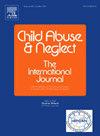Characterizing typologies of overlapping IPV & VAC in the home: Findings from DRC, Ethiopia, and South Africa
IF 3.4
2区 心理学
Q1 FAMILY STUDIES
引用次数: 0
Abstract
Background
While intimate partner violence (IPV) and caregiver-perpetrated violence against children (VAC) are recognized as global epidemics, gaps persist in understanding the nature of co-occurring violence within the home.
Objective
This study seeks to characterize the nature and overlap of concurrent IPV and caregiver-perpetrated VAC in families across three African contexts.
Participants and setting
A sample of adult women and children was obtained from the [study name redacted] Wave 1 (2018–2019), [study name redacted] DRC baseline (2019–2020), and [study name redacted] South Africa Wave 3 (2022–2024) studies.
Methods
Latent class analysis (LCA) distinguished groups of families by nature and overlap of IPV and VAC. Violence was conceptualized as one construct in DRC and South Africa and two constructs in Ethiopia.
Results
Co-occurring IPV and VAC affected 18.3 % of families in South Africa, 34.3 % in Ethiopia, and 56.1 % in DRC. Twenty percent of Ethiopian families, 15.3 % in DRC, and 4.5 % in South Africa, were characterized by emotional IPV alongside both physical and psychological VAC. In Ethiopia, two classes were distinguished by presence of economic abuse related to either women's earnings (4.1 %) or men's earnings (4.3 %). Systematic violence, characterized by overlap of multiple domains of IPV alongside VAC, affected 15.5 % of families in DRC, 8.2 % in South Africa, and 3.2 % in Ethiopia.
Conclusions
Efforts to measure and address IPV and VAC should include emotional and economic IPV, and consider variation of types and intensity across families. More substantial investment in GBV and VAC services are needed to address shared drivers and ensure coordinated response.
家庭中IPV和VAC重叠的类型特征:来自刚果民主共和国、埃塞俄比亚和南非的研究结果
虽然亲密伴侣暴力和照料者实施的暴力侵害儿童行为被认为是全球流行病,但在了解家庭内同时发生的暴力行为的性质方面仍然存在差距。目的:本研究旨在描述三个非洲家庭中并发IPV和照顾者犯下的VAC的性质和重叠。从[研究名称已编辑]第1波(2018-2019)、[研究名称已编辑]刚果民主共和国基线(2019-2020)和[研究名称已编辑]南非第3波(2022-2024)研究中获得成年妇女和儿童样本。方法采用潜类分析(LCA),根据IPV和VAC的性质和重叠程度来划分科群。暴力在刚果民主共和国和南非被定义为一个概念,在埃塞俄比亚被定义为两个概念。结果南非、埃塞俄比亚和刚果(金)分别有18.3%、34.3%和56.1%的家庭感染了sco发生的IPV和VAC。20%的埃塞俄比亚家庭、15.3%的刚果民主共和国家庭和4.5%的南非家庭的特点是情感上的IPV以及身体和心理上的VAC。在埃塞俄比亚,存在与妇女收入(4.1%)或与男子收入(4.3%)有关的经济虐待,从而区分出两个阶层。在刚果民主共和国,15.5%的家庭、8.2%的南非家庭和3.2%的埃塞俄比亚家庭受到系统性暴力的影响,其特征是IPV和VAC的多个领域重叠。结论衡量和解决IPV和VAC应包括情感IPV和经济IPV,并考虑不同家庭IPV的类型和强度差异。为解决共同驱动因素和确保协调应对,需要加大对性别暴力和空气污染服务的投资。
本文章由计算机程序翻译,如有差异,请以英文原文为准。
求助全文
约1分钟内获得全文
求助全文
来源期刊

Child Abuse & Neglect
Multiple-
CiteScore
7.40
自引率
10.40%
发文量
397
期刊介绍:
Official Publication of the International Society for Prevention of Child Abuse and Neglect. Child Abuse & Neglect The International Journal, provides an international, multidisciplinary forum on all aspects of child abuse and neglect, with special emphasis on prevention and treatment; the scope extends further to all those aspects of life which either favor or hinder child development. While contributions will primarily be from the fields of psychology, psychiatry, social work, medicine, nursing, law enforcement, legislature, education, and anthropology, the Journal encourages the concerned lay individual and child-oriented advocate organizations to contribute.
 求助内容:
求助内容: 应助结果提醒方式:
应助结果提醒方式:


